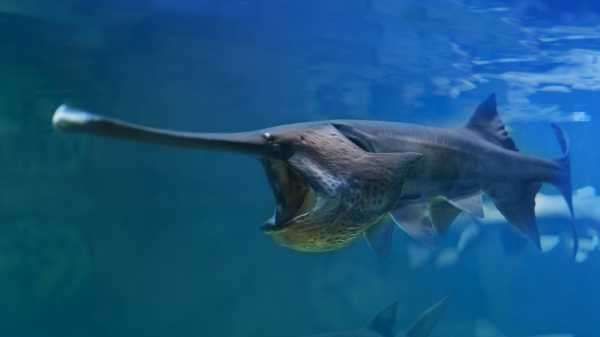
The Chinese paddlefish is one of the world’s largest freshwater fish.
One of the largest freshwater fish in the world may be extinct.
In a new paper, scientists led by Hui Zhang of the Chinese Academy of Fishery Sciences in Wuhan, China, argued that the Chinese paddlefish (Psephurus gladius) is no more, probably having gone extinct sometime between 2005 and 2010. The fish was once common in the Yangtze River in China, the researchers wrote, but overfishing and habitat fragmentation sealed the species’ doom. And there is no hope for bringing it back.
, referring to the International Union for Conservation of Nature’s list of threatened and endangered species.
The Chinese paddlefish was an impressive creature, with a large, protruding snout. This nose gave the fish one of its nicknames, xiang yu, or “elephant fish” in Mandarin. The paddlefish could grow as long as 23 feet (7 meters), putting it among sturgeon and alligator gar as the largest freshwater fish in the world. Paddlefish were caught regularly in the Yangtze River as late as the 1970s, according to Zhang and his colleagues. In 1981, a major dam, the Gezhouba Dam, was built in the river and split the Chinese paddlefish population in two.
The dam also prevented fish trapped below it from swimming upstream to tributaries where they could spawn. The species was listed as one of China’s most threatened animals in 1989, but the population continued to decline despite that listing. The last sighting of a Chinese paddlefish was in 2003.
Now, Zhang and his team wrote, the paddlefish is gone. The researchers scoured records of sightings dating back to 1981 and conducted field surveys in 2017 and 2018 of the Yangtze and its tributaries and lakes: the Yalong River, the Heng River, the Min River, the Tuo River, the Chishui River, the Jialing River, the Wu River, the Han River, Dongting Lake and Poyang Lake. The researchers set up fishing nets to capture species in these waterways and surveyed local fish markets, looking for evidence that this paddlefish species might still be caught.
They found 332 species of fish but not a single Chinese paddlefish. The historical sighting data suggested that few of the paddlefish were seen after about 1995. The evidence suggested that the fish upstream of the dam became functionally extinct — unable to reproduce in the natural environment — by about 1993. The species hung on until around 2005, or perhaps 2010 at the latest, the researchers said.
“Based on the weight of the evidence, the species can be declared as extinct with high certainty,” the researchers wrote.
The loss of the Chinese paddlefish holds lessons for how to ensure the survival of other threatened Yangtze species, the researchers wrote. First, more-frequent surveys of the river basin would allow scientists to keep closer tabs on what species are struggling. Before the 2017 survey conducted by Zhang and his team, the last comprehensive fish survey of the Yangtze and its tributaries occurred in 1975. Second, rescue efforts should begin much more quickly, the researchers wrote. Most of the intense work done to save the Chinese paddlefish started after 2006, likely after the fish was gone. To prevent the species’ extinction, rescue efforts should have started before 1993, when the fish became functionally extinct, the researchers said.
Many Yangtze species, such as the Chinese alligator (Alligator sinensis), are hanging by a thread, Zhang and his team wrote, but might still be saved. Prioritizing their survival now, before they pass the point of no return, may be the only way to save the enormous river’s biodiversity, the researchers said.
Originally published on Live Science.

Want more science? Get a subscription of our sister publication “How It Works” magazine, for the latest amazing science news.
Sourse: www.livescience.com





